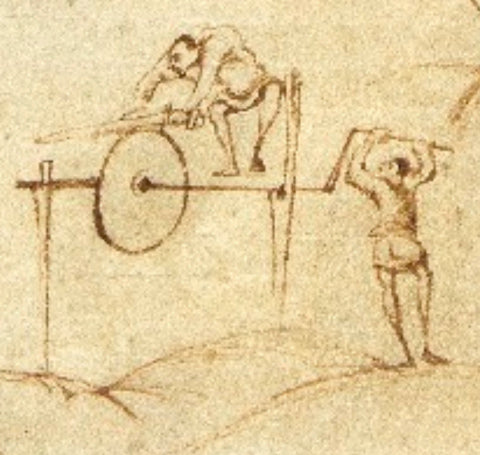The last steps of making a sword blade are the finish polish and edging. In part 1 of this theme, we looked at the use of scrapers to finalize the shape and form of a blade. The remainder of that process is the polish. The key to understanding polishing is to remember that polishing is just a successive series of scratches that are finer and finer in depth. This can be done with a variety of grits and compounds applied in different ways to achieve a finish acceptable to the customer.
Today almost all commercial blade makers use belt grinders to accomplish their grinding. These employ belts which range from 36 grit (very coarse) to several thousand (very fine) for a very high polish. Most modern swords are going to be finished somewhere in the 600 – 1000 grit range, but there is more to it than that.

Modern belt grinding
Today many makers work at different angles of approach to the surface. For example, working the length of the blade then working the width of the blade with a finer grit. Each step working until the marks of the previous grit have been obscured by new scratches. In the historical manufacture of weapons this would only have been applied to the very highest of status pieces in most cases. It takes effort and time and if the customer is not willing to pay for the extra work it is not required.
We do know grinding wheels where available, at least in the best of circumstances, as the same source for our early scraper also shows a grinding wheel being used in the mid 9th C.

9th C Utrecht Psalter image of grinding wheel
In the early part of European blade production hand labor in the polishing was probably dominate. Later with a wider distribution of rotating grinding wheels, both human powered and then water driven, almost certainly we see a shift to a greater use of heavy grinding and less work with scrapers and hand finishing. The marks left by this process, when they can be detected, indicates the finishing being done in one direction whether being worked the length of the blade or cross grinding across the width of the blade. In the areas of recessed surfaces (i.e. fullers) this would mean the blade can really only be worked along the length. (see vid below)
In the medieval period the polishing would be done in the same circumstances as the scraping we looked at in part 1. In my opinion some of these images may well represent the scraping and the polishing going on at the same time. This would be accomplished by having a loose grit medium that is spread on the blade and pushed back and forth with a tool like the scraping tools we see opposite. They would most likely have some type of cloth or leather layer to help hold the grit in place when working the surface of the blade but would not hinder the pressure being applied.

14th C Bodleian Library MS. Bodl. 264 A: using a shaping or scraping tool, B: polishing possible compound held in horn mounted on side of bench
This process leaves heavier grit streaks or lines in the smoother finished surface as it is polished. This can be seen in many artifacts from the period but is quite noticeable in even the highest status sword blades and suits of armor. Seeing these streaks in a piece helps one get a better handle on the mind of maker and consumer in the medieval period. How we approach a tool in our craft and what characteristics matter to us as users can be different than those users of the past, that is fine. But we also need to keep this in mind when we study the artifacts of the past and how they were worked. We need to guard against letting our jaundiced eye with a modern focus encroach when we marvel at their skill, talent and focus.
In the following video I use a few real-world examples from The Oakeshott Institute to illustrate and confirm the way blades were viewed by their makers and users across several centuries in the European context.
We will continue in part 3 to look more closely at the processes used in period and the tools we have from that period to see how this was done.

Nathan Clough, Ph.D. is Vice President of Arms and Armor and a member of the governing board of The Oakeshott Institute. He is a historical martial artist and a former university professor of cultural geography. He has given presentations on historical arms at events including Longpoint and Combatcon, and presented scholarly papers at, among others, The International Congress on Medieval Studies.
Craig Johnson is the Production Manager of Arms and Armor and Secretary of The Oakeshott Institute. He has taught and published on the history of arms, armor and western martial arts for over 30 years. He has lectured at several schools and Universities, WMAW, HEMAC, 4W, and ICMS at Kalamazoo. His experiences include iron smelting, jousting, theatrical combat instruction and choreography, historical research, European martial arts and crafting weapons and armor since 1985
